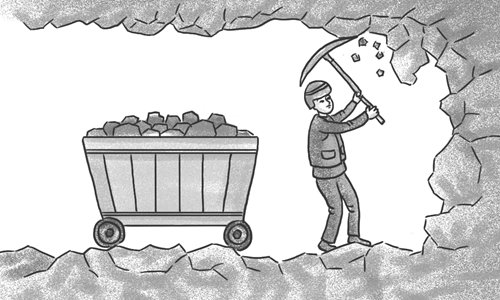HOME >> BUSINESS
US rare earths diversification efforts hardly reduce reliance on Chinese supply
By Wang Jiamei Source:Global Times Published: 2019/7/25 20:30:43

Illustration: Xia Qing/GT
Recent media reports suggest that the US is turning to Africa to diversify its rare-earth supplies away from China. Yet, in view of the US and Africa's lack of rare-earth-processing capacity, the move will hardly help the US reduce its reliance on China's rare-earth supplies.
Rare-earth elements refer to a group of 17 chemically-coherent elements that are critical to the manufacturing of a wide range of high-tech products, including but not limited to batteries, electronic devices and wind turbines. At present, China, holding a third of the world's rare-earth reserves, accounts for more than 70 percent of the global output of rare earths.
Yet, it has almost become something of a cliché that despite their name, rare earths are not particularly rare. Russia, Greenland, Canada, Vietnam, the US and some African countries all have abundant reserves of rare earths. In particular, the African continent seems to be the most promising potential supplier of rare earths after China, as geologists claim that it contains half of the world's deposits of carbonatites and vast amounts of monazite sands, from which rare-earth elements can be extracted. Currently, rare-earth projects are well-dispersed in quite a number of African countries, including the Kangankunde and Songwe mines in Malawi, the Nkombwa Hill mine in Zambia, the Wigu Hill mine in Tanzania, the Lofdal mine in Namibia, the Mrima Hill mine in Kenya, the Steenkampskraal and Glenover mines in South Africa and the Gakara mine in Burundi.
Given the abundant rare-earth resources, it makes sense for the US to turn to Africa in its diversification efforts. According to a recent Reuters report, the US has held talks with Malawi's Mkango Resources whose Songwe mine is still years from entering production. The US has also held talks with Rainbow Rare Earths Ltd, which runs the Gakara mine in Burundi, the only African mine currently producing rare earths. The company reportedly aimed toward an annual production target of 5,000 tons of rare-earth concentrates.
While rare-earth elements may be easy to find, they are not that easy to produce without a reliance on China, which not only controls nearly all of the world's processing capacity but also boasts relatively clean and efficient processing technologies.
At present, Mountain Pass in California runs the only operational rare-earth mine in the US, and it still needs to export the extracted rare earths to China for processing. According to a report carried out by consultancy firm Adamas Intelligence, China imported 41,400 tons of rare-earth oxides and oxide equivalents in 2018, including a large amount of ores rich in lanthanum from the US.
A Reuters report pointed out in June that China's rare-earth processing capacity, which is currently around 220,000 tons, is five times the combined capacity of the rest of the world, meaning that it would take years for the US to catch up. At present, there are three US companies that have rare-earth processing plants under construction or in planning.
Apart from one that is set to open next year at Mountain Pass mine, the other two will not be operational until 2022 at the earliest. Even when all three become operational, it will still be extremely difficult to develop a complete processing industrial chain for rare earths and this will not be solved immediately.
Meanwhile, it should also be noted that extracting rare-earth elements is an unclean industry that brings serious environmental pollution to a region. Since China curbed rare-earth exports temporarily in 2010, the West has felt the need to build up their own processing capacity, but no country is willing to build the plants within their borders. For instance, Australia's Lynas Corp, the biggest producer of rare earth products outside China, was criticized for the radioactive waste coming from its Malaysian processing plant.
It remains unclear whether African countries like South Africa and Tanzania will be willing to bear the pollution cost of the rare-earth processing industry.
As to China, the country has also paid great environmental cost to enter the rare-earth sector, which pushed the Chinese government to invest heavily in improving the processing and separation technology of rare earths. Now Chinese scientists have already developed a clean and efficient rare-earth processing technology system, meaning that Beijing has strengthened its grip on the rare earths supply chain in terms of both quantity and quality. Such technological advantage is the real basis for China's prominent position on the global rare earths market.
The author is a reporter with the Global Times. bizopinion@globaltimes.com.cn
Posted in: EXPERT ASSESSMENT